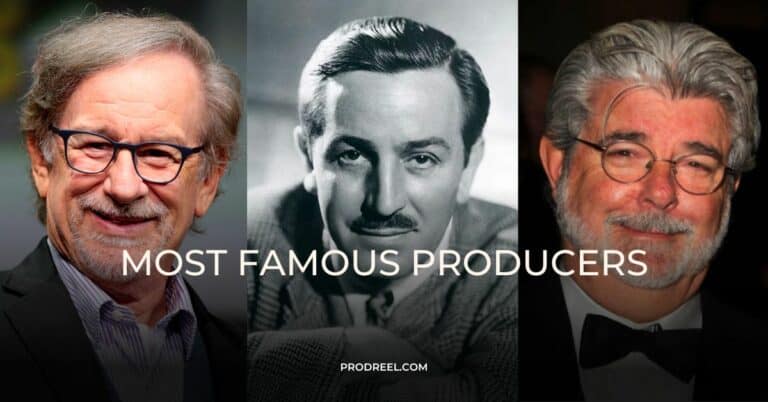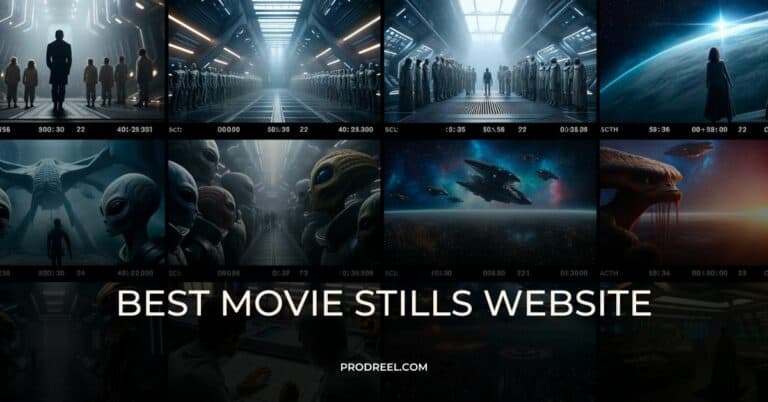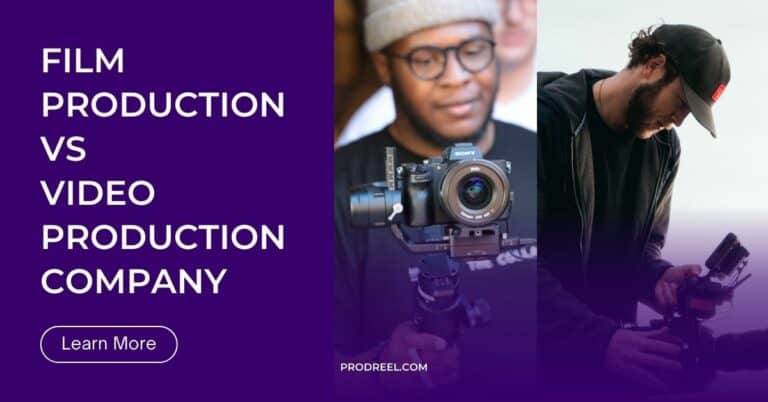Introduction
Video production is a vibrant, multi-faceted process that transforms a concept or story into a visual and auditory masterpiece.
For the aspiring marketer, business owner, or video production novice, understanding this process is a crucial step on the path to effectively harnessing the power of video content.
This article will provide an instructional and educational guide to the basics of video production, equipping readers with the knowledge they need to begin their journey into this creative and rewarding field.
What is video production?
Video production is the process of creating video content. It’s like making a movie, but it can be any length and for any purpose, not just for entertainment.
The process generally involves three stages
- pre-production
- production and
- post-production
Whether it’s for marketing a product, educating an audience, or telling a story, video production is a key skill in today’s digital world.
Why is Video Production important?
Video production is crucial for numerous reasons. Here are some of the most key reasons –
1. Increasing Demand and Consumption
With the rise of digital platforms and high-speed internet, the demand for and consumption of video content have skyrocketed.
People spend hours every day watching videos on platforms like YouTube, Netflix, and social media. Short-form video content has also gained massive popularity, with platforms like TikTok and Instagram Reels leading the charge.
This increasing consumer appetite for video content is creating a greater need for high-quality video production. Businesses, influencers, and educators alike are finding that video content is a key aspect of their strategy to attract and retain their target audience.
By keeping up with this trend and producing high-quality video content, you can meet your audience where they’re spending their time and attention.
2. Visual Engagement
Humans are visual creatures, and video is one of the most engaging forms of media. It can deliver information in an easily digestible format, keeping audiences engaged longer than other forms of content.
3. Versatility
Video can serve many purposes – education, entertainment, marketing, training, communication, and more. This makes it a versatile tool in almost any field, from business to education to media.
4. Effective Communication
Video combines visual elements, sound, and text, allowing for rich and nuanced communication. It’s effective for explaining complex ideas and concepts, as well as for emotional storytelling.
5. Brand Awareness
Videos can effectively communicate your brand’s identity, values, and offerings, increasing visibility and recognition. They can also evoke emotion, leading to a deeper connection with your audience.
6. Increased Conversion Rates
Videos can help businesses increase conversion rates. For instance, explainer videos or product demos can help potential customers understand your product, leading to increased sales.
7. SEO Benefits
Videos can also improve your website’s SEO. Search engines prioritize websites that include videos, which can lead to higher search rankings.
8. Social Media Engagement
Videos are the most shared content type on social media, leading to higher engagement, increased organic reach, and opportunities for viral content.
9. Building Trust
Videos can help build trust with your audience. Testimonial videos or behind-the-scenes videos can showcase your transparency and authenticity.
10. Accessible to Anyone
With the widespread availability of smartphones and affordable editing software, anyone can create a video. This democratizes the ability to share stories and messages widely.
11. Improving Remote Work and Learning
In the era of remote work and learning, video has become crucial for communication and education. From virtual meetings to online courses, video helps make remote collaboration possible.
Types of Video Productions
Following are the most common types of video production, categorized into Corporate Video Types of Commercials along with their common distribution channels.
| Video Type | Category | Distribution Channels |
|---|---|---|
| Social Media Videos | Commercial | Social Media platforms |
| Advertising Videos | Commercial | TV, Online, Social Media |
| Product Demos | Both | Company Websites, Online Marketplaces |
| Tutorials | Both | YouTube, Company Websites |
| Online Videos | Both | Various Online Platforms, Social Media |
| Corporate Videos | Corporate | Company Websites, Corporate Events |
| News Videos | Both | News Sites, Social Media |
| Music Videos | Commercial | YouTube, VEVO |
| TV Commercials | Commercial | Television, Online |
| Commercials | Commercial | Television, Online, Social Media |
| Product Videos | Both | Company Websites, Online Marketplaces |
| Help & How-to Videos | Both | YouTube, Company Websites |
| Webinars | Corporate | Company Websites, Webinar Platforms |
| Branded Videos | Both | Company Websites, Social Media |
| Video Interviews | Both | News Sites, Company Websites |
| Testimonial Videos | Both | Company Websites |
| Short Films | Commercial | Film Festivals, Online Platforms |
| Company News Videos | Corporate | Company Websites |
| Customer Stories | Both | Company Websites, Social Media |
| Video Live stream | Both | Social Media, Video Streaming Platforms |
| Virtual Events | Corporate | Company Websites, Video Streaming Platforms |
| Walkthroughs | Both | YouTube, Company Websites |
| Speaker Videos | Both | YouTube, Company Websites |
| Behind the scenes Videos | Both | Social Media, Company Websites |
| Recruitment Videos | Corporate | Company Websites, Job Posting Sites |
| Events Videos | Both | Social Media, Company Websites |
| Teasers | Commercial | Social Media, Online |
| Remote Production Videos | Both | Various Online Platforms |
| Company Stories | Corporate | Company Websites |
| Case Study Videos | Corporate | Company Websites |
| Podcasts | Both | Podcast Platforms, Company Websites |
| Animations | Both | Various Online Platforms, Social Media |
| Documentary | Both | Film Festivals, Online Platforms, TV |
| Series | Commercial | Television, Online Platforms |
Social Media Videos
These are short, catchy videos created specifically for platforms like Instagram, Facebook, and TikTok. They are designed to engage followers, increase brand visibility, and promote user interaction.
Advertising Videos
These videos are created to advertise a product, service, or brand. They can be displayed on television, online platforms, or even movie theaters, and are designed to capture attention and inspire action.
Product Demos
Product demonstrations show how a product works. They can be used to showcase features, provide user instructions, or highlight the benefits of a product, and are often found on product pages or e-commerce platforms.
Tutorials
These are instructional videos designed to teach viewers how to perform a task or use a product. They are often found on websites, blogs, and platforms like YouTube.
Online Videos
This is a broad category that encompasses any video content distributed online. This can range from promotional content to educational videos to entertainment.
Corporate Videos
These are videos produced by a company or organization for internal or external purposes. They can be used to share company news, showcase company culture, provide training, or communicate with stakeholders.
News Videos
These videos provide current news and updates. They can be found on television broadcasts, online news sites, or social media platforms.
Music Videos
Music videos are produced to accompany a song or album. They provide visual context and storytelling for the music and are primarily distributed on platforms like YouTube and Vevo.
TV Commercials
These are short videos designed to promote a product, service, or brand on television. They aim to persuade viewers to take a specific action, such as buying a product or visiting a website.
Commercials
Similar to TV commercials, these videos advertise a product, service, or brand. However, they can be distributed across a variety of platforms, not just television.
Product Videos
These videos showcase a product’s features and benefits. They can be used on product pages, in advertising campaigns, or on social media platforms to engage potential customers.
Help & How-to Videos
Similar to tutorial videos, these instructional videos guide users through a process, answering common questions and providing helpful information about a product or service.
Webinars
Webinars are online seminars or presentations. They are typically used for educational purposes, such as providing information about a product or teaching a specific skill or topic.
Branded Videos
These videos are designed to build brand recognition and identity. They may not directly promote a product or service, but rather aim to establish a connection with the audience and communicate the brand’s values and personality.
Video Interviews
These are videos in which one person asks another questions. They can be used in a variety of contexts, from job interviews to celebrity interviews to expert insights on a specific topic.
Customer Testimonial Videos
These videos feature customers talking about their positive experiences with a product or service. They serve as powerful social proof and can significantly influence potential customers.
Short Films
Short films are narrative or documentary videos that are shorter than a full-length movie. They are often used for artistic expression or to communicate a specific message or story.
Company News Videos
These videos provide updates and news about a company. They can cover a range of topics, from product launches to company achievements to changes in leadership.
Customer Stories
These are testimonials or case studies from customers who have had a positive experience with a product or service. They provide social proof and help build trust with potential customers.
Video Livestream
This is a live video broadcast over the internet. It can be used for a variety of purposes, from gaming streams to live Q&A sessions to real-time event coverage.
Virtual Events
These are events that take place online rather than in person. They can range from virtual conferences to webinars to live-streamed performances.
Walkthroughs
These are instructional videos that guide viewers through a process step by step. They are often used for software or game tutorials, but can also be used for physical tasks.
Speaker Videos
These videos feature a person speaking about a specific topic. They can be used for motivational speeches, conference presentations, or educational lectures.
Behind the Scenes Videos
These videos provide a look at what happens behind the scenes of a product, event, or company. They can provide insight into the production process, showcase company culture, or provide exclusive content for fans or followers.
Recruitment Videos
These videos are used to attract potential employees. They can showcase company culture, highlight employee experiences, or provide information about job opportunities.
Events Videos
These videos capture highlights or footage from an event. They can be used to share the experience with those who couldn’t attend, provide a recap for attendees, or promote future events.
Teasers
Teaser videos provide a brief glimpse or preview of an upcoming product, event, or video. They are designed to build anticipation and excitement.
Remote Production Videos
These are videos that are produced remotely, often with contributors in different locations. They have become increasingly common in the context of remote work and virtual collaboration.
Company Stories
These videos tell the story of a company, including its history, values, and mission. They can be used to connect with customers, attract employees, or communicate with stakeholders.
Case Study Videos
Case study videos provide a detailed look at a specific project, campaign, or success story. They can be used to demonstrate the value of a product or service, or to share insights and lessons learned.
Podcasts
While not technically videos, podcasts are often recorded with video as well as audio. They can be used to discuss a variety of topics, interview guests, or provide educational content.
Animations
Animation videos use animated graphics to tell a story or explain a concept. They can be particularly effective for abstract or complex topics, as they can simplify information and make it more engaging.
Documentaries
These are non-fiction videos that document reality. They can cover a wide range of topics, from historical events to personal stories to investigative reporting.
Series
A series is a set of videos that are related and released sequentially. They can cover a variety of topics and can be used for everything from educational content to entertainment.
The Stages of Video Production
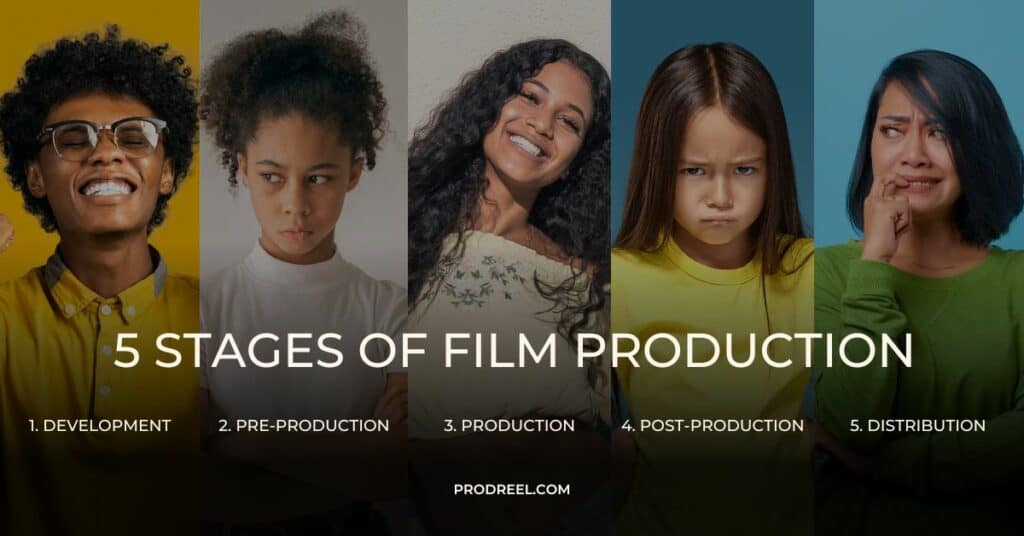
Following are the most common stages of a video production. Know them is crucial in understanding the overall workflow and timeline of a video production project.
Stage 1 – Development
The development phase is the first step in video production, where ideas are conceived and planning begins. This stage involves brainstorming, scriptwriting, and storyboarding, essentially laying out the groundwork for the entire project.
If you are looking for mood, tone, lighting inspirations for your next creative project, then check out our recommended best film stills website.
Stage 2 – Pre-production
Pre-production is the planning phase where everything needed for filming is organized. This includes casting, scouting and securing locations, gathering props and costumes, scheduling shoot dates, and preparing equipment. It’s all about making sure everything is in place before the cameras start rolling.
Stage 3 – Production
The production phase is where the actual filming occurs. All the preparations come to life as actors perform, directors guide the shoot, and the camera crew captures the scenes. This phase demands meticulous attention to detail to ensure that every shot aligns with the vision outlined in the development phase.
Stage 4 – Post-production
Post-production involves editing and refining the captured footage. Editors cut and arrange clips, add music, sound effects, voice-overs, and special effects. Color grading is performed to ensure visual consistency, and any necessary animations or graphics are added. This phase transforms raw footage into a polished video.
Stage 5 – Distribution
The final phase, distribution, is all about getting the finished video to its intended audience. This could involve uploading the video to online platforms, broadcasting it on television, including it in a marketing campaign, or presenting it at an event. The distribution strategy depends on the video’s purpose and target audience.
Check out the various stages of film and video production to gain an in-depth understanding of the video production process.
Common Video Production Crew
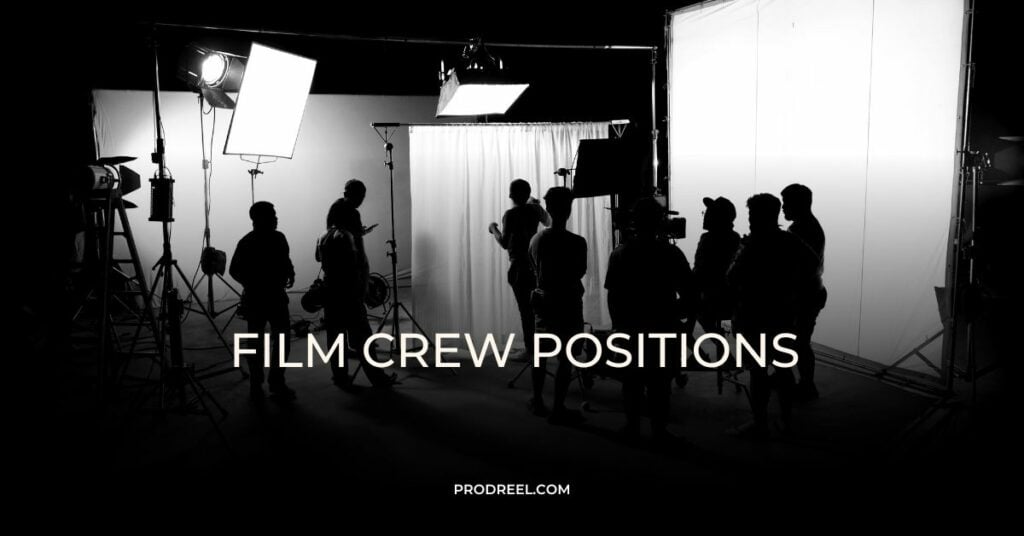
Following are the most essential video production crew members that are involved in a video production project at any given stage of a video production ordered by their involvement in the project –
Producer
The producer is essentially the project manager of the video production. They oversee all aspects of the project, from initial planning and budgeting to post-production and distribution, ensuring everything runs smoothly and on schedule.
Director
The director is the creative leader who guides the overall vision of the video. They work with actors on their performances, make decisions about the look and sound of the film, and coordinate with the crew to bring the script to life.
Screenwriter
The screenwriter is responsible for creating the script, which serves as the blueprint for the video. They craft the story, characters, and dialogue, shaping the narrative structure of the video.
Cinematographer/Director of Photography (DoP)
The DoP oversees all aspects of capturing the video. They work closely with the director to achieve the desired visual look and style, choosing camera angles, lighting, and lenses.
Production Designer
The production designer creates the physical environment of the video. They design, build, and decorate sets, collaborating with the director and DoP to ensure the visual elements support the story.
Sound Designer
The sound designer is in charge of the audio quality of the video. They create and record sound effects, design audio environments, and work on sound mixing in post-production to enhance the video’s auditory experience.
Camera Operator
The camera operator physically operates the camera under the direction of the DoP. They are responsible for capturing the scenes and images as per the cinematographer’s vision.
Makeup Artist/Hair Stylist
These professionals enhance or alter the physical appearance of actors to suit the characters they play. They manage hair, makeup, and sometimes even prosthetics, contributing significantly to the visual storytelling.
Production Assistant (PA)
PAs are the workhorses of the production, handling various tasks from running errands to assisting with setup and breakdown of sets. They provide crucial support to all aspects of the production.
Editor
The editor assembles the footage shot during the production phase, creating the final narrative of the video. They select shots, adjust pacing, add music and sound effects, and work on visual effects in post-production to create the final piece.
A video production project can be a small or a huge task. The crew size can vary anywhere between a few members to a hundreds. We have broken down all the various crew positions and their typical role in a production in a separate post.
How to choose the right type of video production for your needs?
Choosing the right type of video production for your needs largely depends on your goals, audience, budget, and the message you want to convey. Here are some factors to consider:
1. Define Your Goals
Are you trying to increase brand awareness, introduce a new product, educate your audience, or inspire action? The purpose of your video will help determine the most suitable format. For example, if you want to showcase a new product, a product demonstration video might be the best choice.
2. Understand Your Audience
Different types of videos will appeal to different audiences. For instance, younger audiences might engage more with social media videos, while professionals might appreciate webinars or educational content. Understand who your audience is, what they value, and where they spend their time online.
3. Budget
The cost of video production can vary significantly based on the type of video. Animations or high-production value commercials could be expensive, while a simple tutorial video might be relatively affordable. Determine what you’re willing to spend before deciding on the type of video.
4. Message and Brand Voice
Different types of videos can convey different tones and styles. Make sure the type of video you choose aligns with your brand voice and effectively communicates your message. If your brand is serious and professional, a corporate video might be appropriate. If your brand is youthful and fun, a more casual social media video might be a better fit.
5. Distribution Channels
Different video types work best on different platforms. For example, short, catchy videos are ideal for social media, while longer, more detailed videos might be better suited to your website or a platform like YouTube. Consider where you plan to share the video when deciding on the format.
6. Timeline
Some types of videos take longer to produce than others. If you need a video quickly, you might opt for a simpler format like a talking-head video or a product demo. If you have more time, you could consider a more involved production like a short film or animation.
The best video type for your needs will effectively convey your message to your intended audience within your budget and timeline. It’s always a good idea to work with a video production professional who can guide you in making the best choice for your specific needs.
Conclusion
Video production is a dynamic and multifaceted process that shapes our modern digital landscape.
From the conception of an idea to its delivery to an audience, each stage of video production requires strategic planning, creative decision-making, and meticulous execution.
Whether it’s a social media video, an advertising campaign, a tutorial, or a documentary, video content serves as a powerful communication tool that transcends geographical boundaries and cultural differences.
By understanding the nuances of video production, from its types and the roles involved to how to get started, individuals and businesses alike can leverage this medium to convey their messages effectively, engage audiences, and ultimately, tell stories that resonate.
Whether you’re a budding filmmaker or a business owner looking to expand your reach, embarking on the journey of video production can open a world of creative and communicative possibilities.
FAQ
Video production is the process of producing video content, involving stages like pre-production (planning), production (filming), and post-production (editing and finalizing).
While both involve creating visual content, film production typically refers to creating content for cinema using celluloid film, while video production generally uses digital media and covers a wider range of formats, including online videos, corporate videos, commercials, etc.
Different types of video production include commercials, corporate videos, social media videos, educational videos, documentaries, music videos, and many more, each catering to specific needs and audience segments.
A video production brief is a document outlining the objectives, target audience, key messages, and logistical details of a video project, crucial for guiding the production process and ensuring all stakeholders are aligned on the vision.
The stages of video production include development (conceptualizing and planning), pre-production (preparation), production (actual filming), post-production (editing and finishing touches), and distribution (delivering to the audience).
Producers are pivotal in video production as they manage all aspects of the project, from initial planning to final distribution, ensuring everything runs smoothly, on time, and within budget.



